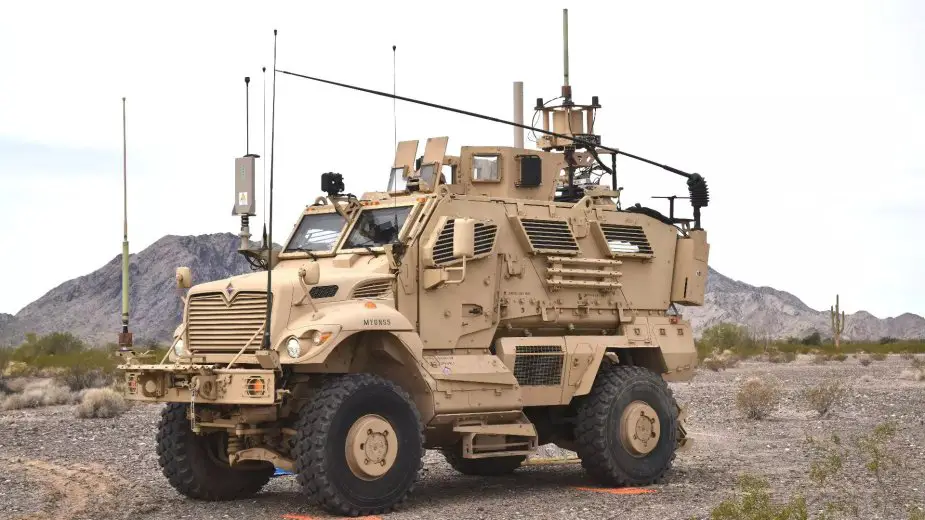As Joseph Trevithick reports on WarZone, elements of the U.S. 1st Cavalry Division have begun testing a new armored vehicle that has the ability to jam enemy communications systems and other emitters. With potential opponents, especially Russia, investing heavily in similar systems, the service is looking to reinvigorate its own electronic warfare capabilities, which largely eroded after the end of the Cold War.

The EWTV uses a 4x4 M1235 Mine-Resistant Ambush Protected (MRAP) 4x4 armored truck to carry the complete electronic warfare package (Picture source: U.S. Army)
The EWTV uses a 4x4 M1235 Mine-Resistant Ambush Protected (MRAP) 4x4 armored truck to carry the complete electronic warfare package. SRC, Inc. is the supplier and has based it around a modified version of their AN/VLQ-12 Duke jammer, according to Breaking Defense. Duke is an outgrowth of a U.S. Army development effort to defeat remote-controlled improvised explosive devices that began in 2005, known as Counter Radio Controlled Improvised Explosive Device Electronic Warfare, or CREW.
The initial versions of the AN/VLQ-12 went into Humvees, MRAPs, and other Army armored and unarmored vehicles, to provide short-range jamming to prevent terrorists and insurgents from setting off those bombs with cell phones and other remote triggers. SRC has since upgraded the range, power, and capabilities of the Duke system, though, and the latest iterations have the ability to scramble a wider array of signals. The company even demonstrated its ability to knock down drones during one of the U.S. military’s Black Dart counter-unmanned aerial vehicle exercises, Breaking Defense noted.
On its website, SRC also now offers what it calls “Integrated Electronic Warfare Systems,” which add “plug-in” modular components to Duke. These additional systems provide direction finding, electronic attack, and signal recording capabilities, to allow personnel to better spot hostile emitters and then decide to either attack them or monitor their activities. It seems very likely that the EWTV carries Duke with one or more of these additional components. The vehicle also features various antennas on an extendable mast that would help expand the coverage area of the vehicles. Line-of-sight communication systems often have trouble transmitting across complex terrain, such as hills and mountains, and from within constrained urban areas. Jammers, which flood those emitters with electronic “noise,” have the same limitations.
Earlier in September 2018, the 1st Cavalry Division’s 3rd Brigade Combat Team sent personnel to the Yuma Proving Ground in Arizona for a two-week course in operating the new system, known as the Electronic Warfare Tactical Vehicle (EWTV). In August 2018, the Army’s Rapid Equipping Force (REF) first announced plans to build the EWTVs on a prototype basis for field testing in the United States, as well as potentially Europe and South Korea.
This kind of multi-functional electronic warfare system would give Army units the ability to quickly identify the location of potential hostile units, helping commanders either avoid potential threats or decide how best to attack against them, as well as just gain a better overall picture of how the enemy is positioned around the battlefield. Troops could then decide to jam their transmissions, hampering their opponent's ability to coordinate their own offensive and defensive operations, warn their comrades of an approaching American force, or request reinforcements or supporting air and artillery strikes.
SRC’s integrated concept also includes networked, data-sharing capabilities, which could allow multiple EWTVs to quickly share information with each other, with other Army units, and with other U.S. military or allied forces. Depending on the range and capabilities of any direction finding or geo-location functionality the new vehicle-mounted system has, it might be able to provide target information to directly cue friendly artillery or airstrikes. The EWTV remains an experimental capability.
Russia, and to a lesser extent China, has been pouring resources into the development of ground-based electronic warfare systems of varying sizes and capabilities, many of which are mobile and some of which can jam radios and radars at relatively long ranges. The Russians have reportedly been employing some of these systems against U.S. and U.S.-backed forces in Syria. So, in addition to developing systems such as the EWTV, the Army is planning to reestablish CEWI-type units – as part of a larger operating concept it has now dubbed Cyber and Electromagnetic Activities (CEMA) – within its combat brigades, which could help get it back on par with potential high-end opponents. There will eventually be electronic warfare companies in each one of its military intelligence brigades, which are dotted around the world to provide support to ongoing and future operations, as well.














